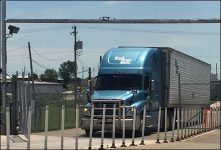
Trailiner uses RFID technology to manage the in and out of warehouse vehicles
[ad_1]
The American refrigerated cargo transporter Trailiner recently announced the deployment of an RFID system to prevent loading and transportation errors, while eliminating the cost of 24-hour guarding of warehouse gates. The RFID system is provided by QuikQ and uses QuikQ RFID tags to help Trailiner manage warehouse entry and exit and prevent loading and transportation errors.
Trailiner provides refrigerated transportation services in 48 states across the United States. The company uses 200 trucks and 300 trailers to transport products to pharmacies and retailers. The company has a storage warehouse in Springfield, where trucks pick up cargo 24 hours a day, 7 days a week.

(QuikQ installed an Impinj Speedway Revolution reader and 2 Invengo reader antennas at the entrance of the storage warehouse for reading)
Around 2005, Trailiner began to look for technology to improve the security of the import and export of storage warehouses. There are employees working at Trailiner site 24 hours a day, but the company does not want to hire an employee to guard the gate 24 hours, so the company began to look for active RFID tags to improve the security of the gate. The system was installed in 2006. An active RFID tag was installed on the inside of the truck’s windshield, and a reader was installed at the entrance and exit to read these tags when the truck entered and exited. Trailiner has also installed active tags on the top of the truck so that the company can understand the removal of goods at any time. In addition, the vehicles of other companies’ logistics providers entering and leaving the warehouse are also attached with active tags.
In 2013, Love began to install QuikQ’s RFID Fuel Addition System (FPS) to help truck drivers automatically refuel. At the same time, Trailiner also faced many active RFID security gate tag failure issues due to the exhaustion of battery power. These tags cannot replace the battery, so they have to be discarded. Amber Edmondson, President of Trailiner, said that identifying the labels of exhausted batteries and replacing them is a big problem. In addition, each active tag costs 24 to 30 dollars, and the replacement cost is quite high, while the cost of a passive UHF tag is only 1 dollar.
Many truck windshields already have a lot of stickers and RFID tags, so Trailiner hopes not to add more clutter. Therefore, the company asked if QuikQ’s existing UHF RFID tags used for fuel addition can be used for gate entry and exit management.
In the FPS system, the company installed an Impinj Speedway Revolution reader and two Invengo reader antennas under the top of the gas station. When the truck enters the fuel lane, the reader antenna will read the tag’s unique ID number, and then transmit the information to the Pos system. When it detects that the truck has permission, the FPS software will activate the fuel pump.
QuikQ CTO Vince Peschio said that QuikQ can use the existing RFID technology Q-Gate of the existing fuel system. For this warehouse management system, QuikQ also installed an Impinj Speedway Revolution reader and two Invengo reader antennas at the gate. QuikQ also uses UHF RFID tags on the truck windshield and the top of the trailer. When the vehicle approaches the warehouse gate, the reader will read the tag ID number. The Q-Gate software will bind the vehicle tag ID number and related distribution orders, and integrate it into the company’s existing transportation management software (TMS). Q-Gate will then determine whether the vehicle has permission to enter and exit. If there is permission, the gate will be opened and let go.
When the driver selects a specific trailer, the administrator will tell the driver which trailer to use. When the driver leaves the trailer, the gate RFID reader will read the vehicle ID number, and then Q-Gate will forward the information to the distribution management software , To determine whether the vehicle is used incorrectly. If the system judges that the vehicle has been used incorrectly, the gate will not be opened for release.

(2 Invengo reader tags installed at the front door)
If a truck without an RFID tag enters the warehouse following other vehicles, the followed vehicle will not be able to leave the warehouse gate.
Edmondson said that the technology can give us more direction. Although the RFID reader installed at the door is a cost, the cost is much lower than the original active tag.
In the future, the company will analyze these data and alert when the vehicle needs maintenance.
[ad_2]



